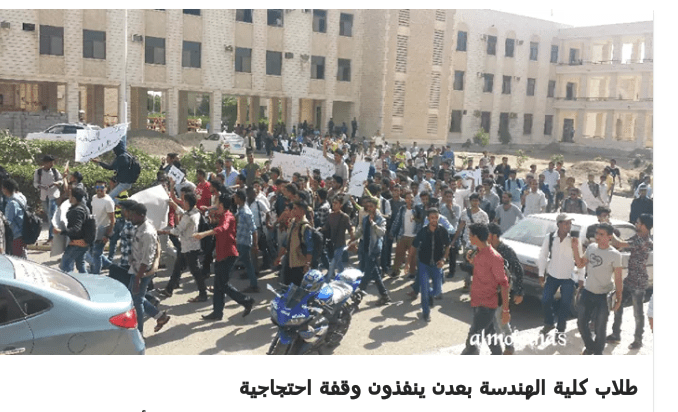 By Mirfat Sulaiman
By Mirfat Sulaiman
Students from the Faculty of Education at Aden University in Yemen walked out of classes during protests on 15 January. Lecturers and students jointly rejected the sacking of the new principal, Dr Mohammed Al-Fakeerh. The students said the real reason for the government’s decision is that Dr Al-Fakeerh rejected its chaotic sale of university lands. The students announced further strikes are to come and said they would continue to protest until the demand for his reinstatement was met.
Meanwhile at Aden University’s Faculty of Engineering, five hundred students walked out on 22 January with the slogan “Give us our rights”. Students’ demands mainly reflect the post war situation in Aden. They called for a cap on the price of food in the university canteen and on stationery. They also demanded the reconstruction of bombed buildings and the provision of electricity generators. In the Civil Engineering Faculty management have marginalised many of the lecturers because they are known to be supporters of the peaceful movement for the independence of South Yemen (Al-Haraak). Dr Aidross al-Yahri’s salary was stopped on this pretext, for example.
The universities of the Yemeni capital Sana’a have recently seen similar strikes over pay, but some of the lecturers have been killed and many have been arrested by the regime.
Yemen has been devastated by war for the last two years: the outcome of counter-revolution and an imposed intervention by external powers acting in their own interests. In 2011 the country witnessed a people’s uprising against dictatorship (in this case the rule of President Ali Abdullah Saleh). In 2013 the Gulf countries, the US and the UK intervened with a shameful treaty which asked Saleh to step down but gave him total immunity from prosecution. The treaty crowned Saleh’s vice-president Abdrabbuh Mansour Hadi as the leader in a one-candidate election. People’s hopes for real change were dashed by the continuation of the same corruption as under Saleh’s regime.
South Yemen was previously the Democratic Republic of Yemen which united with the northern Arab Republic of Yemen in 1990. War broke out in 1994 after the South attempted to withdraw from the union, but was invaded and occupied by Saleh’s forces. The Southerners’ peaceful movement for independence, called Al-Haraak, started in 2007.
The treaty and the election which installed Hadi in power were rejected and boycotted in the South. In 2014-15 a resurgent Saleh with his forces allied with the Houthi movement staged a coup, taking over the capital Sana’a from Hadi and seizing many other cities with little or no resistance. Their troops moved South to Aden but faced resistance, from locals who previously were part of the peaceful movement for independence. They launched an armed resistance movement and fought on the ground for four months. The Gulf states which backed Hadi also bombed the Saleh-Houthi forces which had seized control of the South. Now the South has been freed from the Saleh-Houthi forces, but it is still under the rule of the corrupt Hadi government. However, the struggles in Aden have shifted from armed resistance back to a civil struggle for better living conditions in a country rich in resources.


